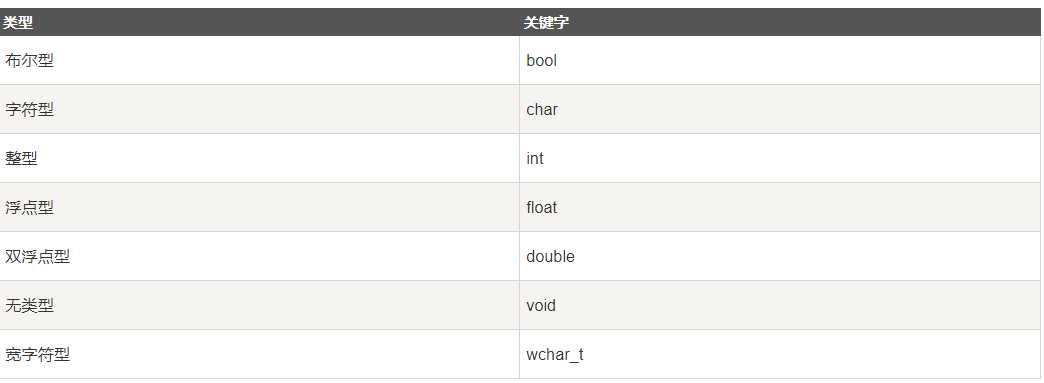C++ 数据类型
2021-01-07 13:29
使用编程语言进行编程时,需要用到各种变量来存储各种信息。变量保留的是它所存储的值的内存位置。这意味着,当您创建一个变量时,就会在内存中保留一些空间。
您可能需要存储各种数据类型(比如字符型、宽字符型、整型、浮点型、双浮点型、布尔型等)的信息,操作系统会根据变量的数据类型,来分配内存和决定在保留内存中存储什么。
基本的内置类型
C++ 为程序员提供了种类丰富的内置数据类型和用户自定义的数据类型。下表列出了七种基本的 C++ 数据类型:

其实 wchar_t 是这样来的:
typedef short int wchar_t;
所以 wchar_t 实际上的空间是和 short int 一样。
一些基本类型可以使用一个或多个类型修饰符进行修饰:
- signed
- unsigned
- short
- long
下表显示了各种变量类型在内存中存储值时需要占用的内存,以及该类型的变量所能存储的最大值和最小值。
注意:不同系统会有所差异,一字节为 8 位。
注意:long int 与 int 都是 4 个字节,因为早期的 C 编译器定义了 long int 占用 4 个字节,int 占用 2 个字节,新版的C/C++ 标准兼容了早期的这一设定。

下面实例会输出您电脑上各种数据类型的大小。
1 #include2 #include type: \t\t" "************size**************" endl; 9 cout "bool: \t\t" "所占字节数:" sizeof(bool); 10 cout "\t最大值:" bool>::max)(); 11 cout "\t\t最小值:" bool>::min)() endl; 12 cout "char: \t\t" "所占字节数:" sizeof(char); 13 cout "\t最大值:" char>::max)(); 14 cout "\t\t最小值:" char>::min)() endl; 15 cout "signed char: \t" "所占字节数:" sizeof(signed char); 16 cout "\t最大值:" char>::max)(); 17 cout "\t\t最小值:" char>::min)() endl; 18 cout "unsigned char: \t" "所占字节数:" sizeof(unsigned char); 19 cout "\t最大值:" char>::max)(); 20 cout "\t\t最小值:" char>::min)() endl; 21 cout "wchar_t: \t" "所占字节数:" sizeof(wchar_t); 22 cout "\t最大值:" ::max)(); 23 cout "\t\t最小值:" ::min)() endl; 24 cout "short: \t\t" "所占字节数:" sizeof(short); 25 cout "\t最大值:" short>::max)(); 26 cout "\t\t最小值:" short>::min)() endl; 27 cout "int: \t\t" "所占字节数:" sizeof(int); 28 cout "\t最大值:" int>::max)(); 29 cout "\t最小值:" int>::min)() endl; 30 cout "unsigned: \t" "所占字节数:" sizeof(unsigned); 31 cout "\t最大值:" ::max)(); 32 cout "\t最小值:" ::min)() endl; 33 cout "long: \t\t" "所占字节数:" sizeof(long); 34 cout "\t最大值:" long>::max)(); 35 cout "\t最小值:" long>::min)() endl; 36 cout "unsigned long: \t" "所占字节数:" sizeof(unsigned long); 37 cout "\t最大值:" long>::max)(); 38 cout "\t最小值:" long>::min)() endl; 39 cout "double: \t" "所占字节数:" sizeof(double); 40 cout "\t最大值:" double>::max)(); 41 cout "\t最小值:" double>::min)() endl; 42 cout "long double: \t" "所占字节数:" sizeof(long double); 43 cout "\t最大值:" long double>::max)(); 44 cout "\t最小值:" long double>::min)() endl; 45 cout "float: \t\t" "所占字节数:" sizeof(float); 46 cout "\t最大值:" float>::max)(); 47 cout "\t最小值:" float>::min)() endl; 48 cout "size_t: \t" "所占字节数:" sizeof(size_t); 49 cout "\t最大值:" ::max)(); 50 cout "\t最小值:" ::min)() endl; 51 cout "string: \t" "所占字节数:" sizeof(string) endl; 52 // ::max)() ::min)() 53 cout "type: \t\t" "************size**************" endl; 54 return 0; 55 }3 4 using namespace std; 5 6 int main() 7 { 8 cout "
本实例使用了 endl,这将在每一行后插入一个换行符,sizeof() 函数来获取各种数据类型的大小。
当上面的代码被编译和执行时,它会产生以下的结果,结果会根据所使用的计算机而有所不同:
1 type: ************size**************
2 bool: 所占字节数:1 最大值:1 最小值:0
3 char: 所占字节数:1 最大值: 最小值:?
4 signed char: 所占字节数:1 最大值: 最小值:?
5 unsigned char: 所占字节数:1 最大值:? 最小值:
6 wchar_t: 所占字节数:4 最大值:2147483647 最小值:-2147483648
7 short: 所占字节数:2 最大值:32767 最小值:-32768
8 int: 所占字节数:4 最大值:2147483647 最小值:-2147483648
9 unsigned: 所占字节数:4 最大值:4294967295 最小值:0
10 long: 所占字节数:8 最大值:9223372036854775807 最小值:-9223372036854775808
11 unsigned long: 所占字节数:8 最大值:18446744073709551615 最小值:0
12 double: 所占字节数:8 最大值:1.79769e+308 最小值:2.22507e-308
13 long double: 所占字节数:16 最大值:1.18973e+4932 最小值:3.3621e-4932
14 float: 所占字节数:4 最大值:3.40282e+38 最小值:1.17549e-38
15 size_t: 所占字节数:8 最大值:18446744073709551615 最小值:0
16 string: 所占字节数:24
17 type: ************size**************
typedef 声明
您可以使用 typedef 为一个已有的类型取一个新的名字。下面是使用 typedef 定义一个新类型的语法:
typedef type newname;
例如,下面的语句会告诉编译器,feet 是 int 的另一个名称:
typedef int feet;
现在,下面的声明是完全合法的,它创建了一个整型变量 distance:
feet distance;
枚举类型
枚举类型(enumeration)是C++中的一种派生数据类型,它是由用户定义的若干枚举常量的集合。
如果一个变量只有几种可能的值,可以定义为枚举(enumeration)类型。所谓"枚举"是指将变量的值一一列举出来,变量的值只能在列举出来的值的范围内。
创建枚举,需要使用关键字 enum。枚举类型的一般形式为:
enum 枚举名{
标识符[=整型常数],
标识符[=整型常数],
...
标识符[=整型常数]
} 枚举变量;
如果枚举没有初始化, 即省掉"=整型常数"时, 则从第一个标识符开始。
例如,下面的代码定义了一个颜色枚举,变量 c 的类型为 color。最后,c 被赋值为 "blue"。
enum color { red, green, blue } c;
c = blue;
默认情况下,第一个名称的值为 0,第二个名称的值为 1,第三个名称的值为 2,以此类推。但是,您也可以给名称赋予一个特殊的值,只需要添加一个初始值即可。例如,在下面的枚举中,green 的值为 5。
enum color { red, green=5, blue };
在这里,blue 的值为 6,因为默认情况下,每个名称都会比它前面一个名称大 1,但 red 的值依然为 0。